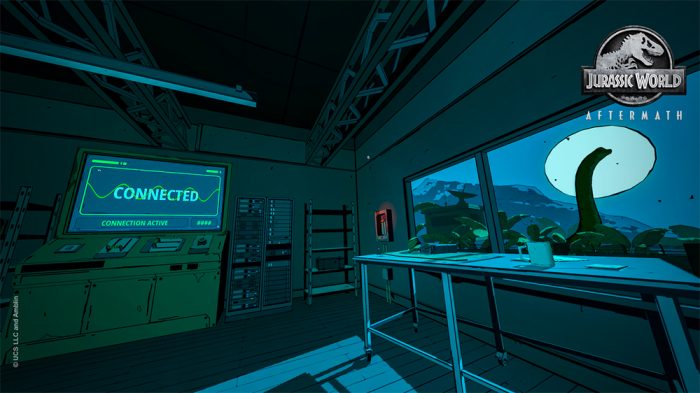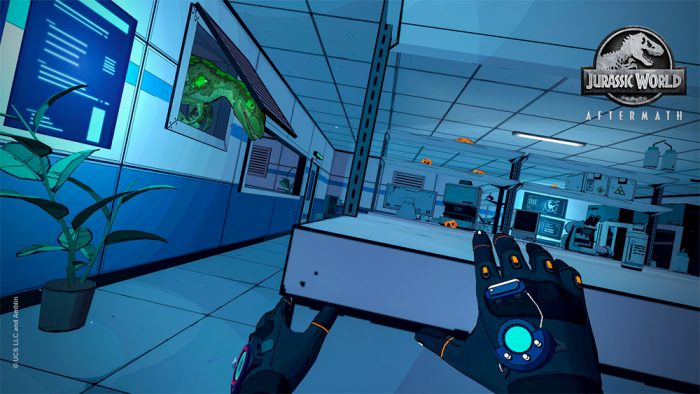'Jurassic World Aftermath' Review: This Hair-Raising Stealth Game Keeps You On Edge But Needs More Variety
Last month, we brought you an in-depth review of Lucasfilm and ILMxLAB's virtual reality video game Star Wars: Tales from the Galaxy's Edge. As a newcomer to the medium of virtual reality, my experience is admittedly limited, but I found the Star Wars VR adventure to be an immersive and thrilling shooter that elevated rudimentary gameplay and a simple story. So when the opportunity came to venture into another blockbuster film franchise in virtual reality, needless to say, I was excited.
Jurassic World Aftermath takes you back to the island of Isla Nublar two years after the fall of Jurassic World and before the events of the sequel Fallen Kingdom. What starts as a mission to collect valuable information turns into a fight for your life as you find yourself stranded on the island and being hunted by velociraptors and dilophosauruses. Your only hope is to navigate the dilapidated remains of Jurassic World's research facilities to gather confidential files in order to facilitate a rescue...if you can survive.
You take the role of Sam, a security expert and professional smuggler whose mission starts off on the worst foot when a pteranodon attack causes his plane to crash. Separated from mission accomplice and park geneticist Dr. Mia Everett, you're tasked with getting the communications tower up and running so you can get a distress signal out to her superiors for an immediate rescue. She's stranded somewhere with a severely injured leg, but thanks to the magic of body camera technology, she can follow along as you make you way through Masrani's research facilities and offer all the guidance you need.
Since the facility is in shambles, it requires a lot of finesse for you to get all the appropriate systems up and running. You have to make your way through endless hallways, offices, labs, computer terminals, control rooms, and more to unlock key codes, realign satellites, download files, and open doors to unlock more areas with tasks that are never done when you think they are. In typical Jurassic Park fashion, things always get worse.
As you make your way through an ever-growing list of systems to stabilize, items to recover, and rooms to unlock, the puzzles you have to solve to complete those tasks are fairly simple. At computer stations and door control panels, you'll have to make it through four-step memory sequences, timed button-pressing, and frequency tuning. The most complicated of these kind puzzles you'll encounter requires you to shift three different controls to align three frequency waves.
I was hoping these might get more challenging or varied as you are forced to dig deeper into Jurassic World's files, but they're the same all the way through. But that's fine, because the real challenge and the most entertaining part of the game is survival, and the presence of dinosaur threats is what makes pulling off these puzzles more difficult as you get deeper into the game.

As you make your way through the research facility, you encounter hungry and ruthless velociraptors. Just like the bloodthirsty dinosaurs in the movies, they're smart, fast, and have impeccable hearing, so stealth is your friend. You'll need to sneak around quietly and cautiously, crouching under desks and tables, crawling through air vents, and hiding in lockers. But be careful not to make too much noise when scrambling to hide, because the velociraptors will come looking for you if you're too loud.
After getting accustomed to the environment and mission at hand, you acquire a helpful tool called the Virtual Interface Assist, a glove that allows you to remotely activate electronic devices around the facility like intercom speakers, radios, and lab screens. This is how you redirect the attention of the velociraptors so you can rush into the next room or quickly move to your next hiding spot as you get closer to your objective. Speaking of which, the halls of this research facility can get repetitive and confusing from time-to-time, but your other hand is equipped with a navigation tool that always tells you where to go and what you're trying to accomplish.
In addition to hiding from velociraptors, players will also encounter the dilophosaurus in a level that adds another layer of tension by immersing you mostly in darkness. You're equipped with a flashlight that you can move around to illuminate a limited amount of space around you, which makes the sudden appearance of the dilophosaurus in air vents and from broken ceiling panels all the more frightening. Just as they do in the movies, these dinos spit venom at you, and while it doesn't exactly hurt you (there's no health bar, just imminent danger or death), it does obscure your vision with sludge, and if you get hit with another blast while already obscured, you're done for. Thankfully, there are valves that you can open to flush your face with water, and your flashlight scares them away like gremlins, so as long as you keep your head on a swivel and move that flashlight all over the place, you'll be fine.
The stealth gameplay is where Jurassic World Aftermath is the most effective. Thanks to ominous surround sound design of the game, the heavy footsteps, piercing shrieks and terrifying calls of nearby velociraptors will stop you in your tracks, forcing you to listen to hear which direction they might be coming from. The sounds of clanging metal and machinery will keep you on edge, not to mention the chirps of the little compsognathus as they scuttle around various parts of the facility. Oh, and that dilophosaurus just keeps popping up, bringing plenty of jump scares. Surprisingly enough, these smaller moments are far more intimidating than a brief encounter with a tyrannosaurus rex after your plane crash.
The suspense of Jurassic World Aftermath is palpable, and you'll find yourself not only tensing up to keep still when you hear a velociraptor nearby, but also moving cautiously and quietly in the middle of your play space, peeking around virtual corners by shifting in your headset. Nothing is more terrifying than realizing you've been spotted by a raptor and barely making it into a locker to hide. Even when you're safe inside a hiding spot, hearing the raptor get closer and seeing its head suddenly pop into your field of vision, especially through the grates of a locker, is a hair-raising, spine-tingling experience. The raptors are so fast that when your screen turns red to indicate their pursuit, you've barely got a few seconds to get out of their reach.

Thankfully, the character movement is fairly smooth, even if shifting your torso is still done in incremental angular turns instead of being a smooth joystick rotation as it would be on console games. There's also no teleporting for quick movement across distances, but in this case, that only adds to the suspense and doesn't really hinder the gameplay. Plus, you can still break into a run (though it makes you louder and more susceptible to being detected) and even slide into a hiding spot if you're really desperate to make a quick getaway. But these raptors are fast and deadly, so patience, observation, distraction, and stealth is your best approach, especially since there aren't any weapons at your disposal.
Jurassic World Aftermath isn't just stealth gameplay for the hell of it though. There's a fairly intriguing story at its center, one that allows you to slowly learn about the complicated career of your remote companion. Dr. Mia Everett claims she became a geneticist to make the world a better place, but her five years working at the park made her hungry for recognition and caused her to have a fallout with Dr. Henry Wu, who appears via flashback recordings (voiced by film franchise co-star B.D. Wong) and also has a part to play in the present day mission. It's not exactly the most compelling or intricate story, but it adds a layer of purpose to the proceedings. Plus, you'll get to hear the voice of Jeff Goldblum as Dr. Ian Malcolm, which is always welcome, and his place in the game will be even bigger in the forthcoming second part that will arrive as downloadable content sometime in 2021.
Not unlike Star Wars: Tales from the Galaxy's Edge, the gameplay in Jurassic World Aftermath is fairly simple. But the immersion of the virtual reality experience makes the suspense and tension that much more enthralling. The only major downside, at least for me, is that the game is created with a cel-shaded visual style that makes it resemble the movie A Scanner Darkly or the video game Ultimate Spider-Man from 15 years ago. It makes the game feel a little cheap, especially if you catch a close-up of some of the art design of the environments. However, I will admit the visual style does allow for certain elements of the game to work well, such as having comic book style graphics that animate loud sounds. But I'm not sure it's enough to justify not making a game that looks more like the "real world" in which the Jurassic World franchise exists.
If you're looking for a way to pass the time until Jurassic World: Dominion arrives in theaters in the summer of 2022, this game will certainly help. It's on the breezier side at roughly three or for hours of gameplay, depending on how many times you find yourself dying, but there are some hidden items to track down in the game that allow for some re-playability. Though I would have preferred a little more variety in the puzzle gameplay as the story progresses and gets more challenging, it's the thrill of being hunted on the abandoned property of Jurassic World that makes this virtual reality experience a solid experience.
Jurassic World Aftermath is available starting today in the Oculus store for $24.99.
